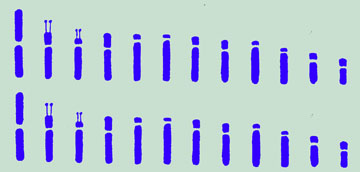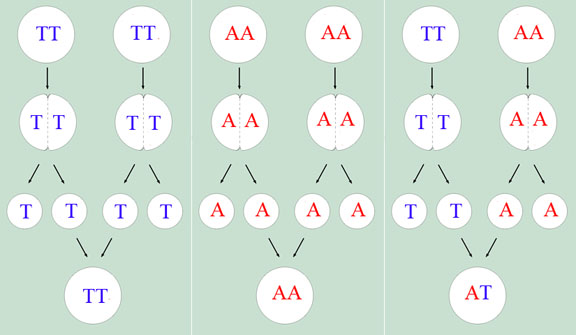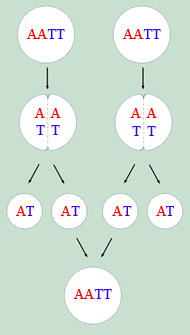Chromosomes: Concepts and Terminology |
Chromosomes: Concepts and Terminology |
Many people are confused or intimidated by talk of chromosome counts and words like "amphidiploid". Although a deep scientific understanding of this subject requires years of study, the hobby iris breeder need only master a few basic ideas to guide a breeding program. This article is intended to help newcomers pick up the key ideas and vocabulary. (A look at my glossary may also be of help.)
Nothing in this article is original with me, or even particularly new. The ideas presented here were all expounded by Dr. Peter Werckmeister, well over half a century ago. (Werckmeister was mentored by the early pioneer of iris genetics, Marc Simonet.) They have been presented many times over the years, in many different iris publications. The aim of this article is to make the material readily available on the web, and perhaps to present it in a way that is easier for nonspecialists to understand.
The genes of a plant or animal determine many of its characteristics. The genes are organized into chromosomes, long strands of DNA within the nucleus of each cell. Usually, two copies of each gene exist, one from each of the organism's parents. They may not be identical copies, but they govern the same characteristic. For example, my brother and sisters each have a gene for brown eyes from my mother and a gene for blue eyes from my father. I have two genes for blue eyes, one from each parent.
 When
an organism prepares to reproduce, it must arrange to pass on only
one copy of each gene to its offspring. What allows this to happen is
the fact that the chromosomes come in sets. A diploid tall bearded
iris such as I. pallida has two sets of 12 chromosomes each,
one set from each parent. (The word "diploid" just means having two
sets of chromosomes.) The illustration at right (adapted from J.
Mitra, "Karyotype Analysis of the Bearded Iris") shows the
chromosomes of I. pallida in a somewhat stylized form. Each
chromosome in the set differs from the others in its length and
structure, but has a match (called a "homolog") in the other set. To
produce the sex cells, each chromosome pairs with its homolog from
the other set, and then they separate so that the cell can divide,
with one moving into one of the new cells and the other moving into
the other one. In this way, each new sex cell receives exactly one
complete set of chromosomes.
When
an organism prepares to reproduce, it must arrange to pass on only
one copy of each gene to its offspring. What allows this to happen is
the fact that the chromosomes come in sets. A diploid tall bearded
iris such as I. pallida has two sets of 12 chromosomes each,
one set from each parent. (The word "diploid" just means having two
sets of chromosomes.) The illustration at right (adapted from J.
Mitra, "Karyotype Analysis of the Bearded Iris") shows the
chromosomes of I. pallida in a somewhat stylized form. Each
chromosome in the set differs from the others in its length and
structure, but has a match (called a "homolog") in the other set. To
produce the sex cells, each chromosome pairs with its homolog from
the other set, and then they separate so that the cell can divide,
with one moving into one of the new cells and the other moving into
the other one. In this way, each new sex cell receives exactly one
complete set of chromosomes.
(This set will not be the same as the set the organism received from either of its parents, as the chromosomes move into the sex cells at random, without regard to which parent they came from. It is this fact that allows new combinations of genes in each generation, and ensures that no two offspring will be identical.)
The single most important concept for understanding how the fertile families work is this: chromosomes must be able to pair to produce sex cells. If they cannot, the plant will be sterile.
In the example of I. pallida, there are two sets of 12 chromosomes. Each chromosome has a homolog to pair with, and each sex cell will receive exactly one complete set of 12.
For a diploid aril, the situation is similar. I. iberica, for example, has two sets of 10 chromosomes. Each chromosome has a homolog to pair with, and each sex cell will receive exactly one complete set of 10.
Both these plants are thus fertile; they have no difficulty producing sex cells. If we cross two plants of I. pallida, the pod parent contributes ovules with 12 chromosomes each, and the pollen parent contributes pollen grains with 12 chromosomes each. When fertilization takes place, a seed is produced with 24 chromosomes, two sets of 12. So we have a new I. pallida plant with the same chromosome arrangement as its parents.
|
|
|
|
|
|
But what if we cross I. pallida with I. iberica? I. pallida contributes a set of 12 bearded iris chromosomes and I. iberica contributes a set of 10 aril iris chromosomes. Not only is the number of chromosomes in each set different, but the chromosomes themselves are of different lengths and shapes in the bearded irises than they are in the arils. The resulting arilbred seedling has 22 chromosomes, a set of 12 and a set of 10. However, the chromosomes in the set of 12 do not have homologs in the set of 10. When it comes time for this iris to reproduce, chromosome pairing cannot occur and new sex cells cannot be produced. Thus the iris will be sterile (as indeed most early arilbreds from this type of cross were).
|
|
|
|
Note that it's not really the number of chromosomes in a set that counts, so much as their structural and chemical similarity. I. reticulata has two sets of 10 chromosomes, but this does not mean it can breed with I. iberica and produce fertile offspring. The aril chromosomes and the reticulata chromosomes are not at all similar; the plants are not at all closely related. The fact that both species have chromosomes in sets of 10 is just a numerical coincidence.
So to make life simpler, I use a different letter for each type of chromosome set. I use T for a set of 12 chromosomes from a bearded iris (like the tall bearded I. pallida), P for a set of 8 chromosomes from a dwarf bearded iris (I. pumila), and A for a set of aril chromosomes (for example a set of 10 chromosomes from I. iberica). Using this notation, it is easy to represent different types of crosses:
I. pallida x I. pallida: each parent is TT, each sex cell is T, the seedling is TT, just like the parents.
I. iberica x I. iberica: each parent is AA, each sex cell is A, the seedling is AA, just like the parents.
I. pallida x I. iberica: the pod parent is TT, producing an ovule that is T; the pollen parent is AA, producing a pollen grain that is A; the seedling is AT.
The first two seedlings are fertile. The pallida seedling is TT, so T pairs with T, producing T sex cells. Likewise the iberica seedling is AA, so A pairs with A, producing A sex cells.
The arilbred seedling is infertile. It is AT. A cannot pair with T, so no sex cells can be produced.

Using the letter notation makes it easy to see at a glance when chromosomes can pair and when they cannot. It's easier to see that the AT arilbred has two different sets than it is to deduce the same conclusion from the fact that it has 22 chromosomes.
Some plants have four sets of chromosomes in each cell instead of two. These are called tetraploids. This happens in nature because sometimes a cell division doesn't happen properly, and a sex cell receives two sets of chromosomes instead of just one. (These are called "unreduced gametes".) Also, the chromosomes can double in the seed or other plant tissue, if a cell prepares to divide but doesn't finish.
Now let's look at how crosses between tetraploids work.
Suppose I take two tetraploid tall bearded irises, say 'Beverly Sills' and 'Gypsy Lord'. Both are TTTT. Each can happily pair to produce sex cells, each of which contains two sets of 12 chromosomes each, TT. Both are thus fertile. The resulting seedlings are again TTTT, fertile tetraploids. In this way, we see that the modern tall beardeds (all of which are TTTT) are a fertile family; they can cross with each other indefinitely, producing fertile offspring.
Likewise the tetraploid arils are AAAA. If we cross I. stolonifera with I. hoogiana, say, each parent will produce AA sex cells, and the seedlings will all be AAAA like the parents.
What if I cross 'Beverly Sills' with I. stolonifera? 'Beverly Sills' produces TT sex cells, I. stolonifera produces AA. The seedlings will be AATT.
 |
 |
 |
|
'Beverly Sills' x 'Gypsy Lord' |
I. stolonifera x I. hoogiana |
'Beverly Sills' x I. stolonifera |
Is an AATT iris likely to be fertile? The answer, quite happily, is yes! When it comes time for this arilbred iris to reproduce, each chromosome can find a homolog. Every chromosome in one A set can pair with a chromosome in the other A set, and likewise the two T sets can pair. A does not pair with T, but they don't need to! It's as though the plant has two large sets of chromosomes, each A+T. These two "supersets" can pair and separate, producing sex cells that are each AT. Such a plant is called an amphidiploid (a "double diploid").
 |
|
|
These amphidiploids constitute a new fertile family. Crossing any two AATT arilbreds (which all produce AT sex cells) yields more AATT seedlings. They can be interbred indefinitely, just like the tall beardeds.
This is why tetraploids are so important in breeding involving wide crosses. If tetraploids are used, the chromosomes of the two parents do not have to be similar enough to pair. The seedlings will be fertile anyway.
So we've seen two types of tetraploids that are fertile and produce fertile offspring when crossed: those where all four chromosome sets are of the same type (TTTT, say - these are called autotetraploids), and those where two sets are of one type and two are of another type, the amphidiploids. Are all tetraploids fertile then? Alas, no. If I cross a fertile amphidiploid arilbred (AATT) with a tall bearded (TTTT), the offspring will be ATTT. It will be difficult for the chromosomes of such a plant to pair. One T set can pair with another T set, but that still leaves one A and one T, which will not be able to pair with each other. This is called an unbalanced tetraploid, such plants are sterile, or at best produce only a few viable sex cells.
What happens if a fertile tetraploid is crossed with a fertile diploid? Again, infertile offspring are the expected result.
Amphidiploid arilbred (AATT) x diploid aril (AA) = AAT.
Tetraploid aril (AAAA) x diploid aril (AA) = AAA.
Tetraploid TB (TTTT) x diploid aril (AA) = ATT.
All of these are triploids (three sets of chromosomes). It should be clear that three sets of chromosomes cannot pair, regardless of what type they are.
If you are knowledgeable about cytogenetics, you're probably irritated by almost everything on this page so far. In reality, things are always more complicated. Simplification has its role, however. If you are new to a subject, it makes sense to learn the rules first and the exceptions later. Here are some of the important exceptions:
The above exceptions imply that sometimes success can result when breaking the rules (or not knowing them) and sometimes failure can result even when you follow the rules. Theory is a guide to effective practice, not an absolute requirement. Nevertheless, the fertile families that emerged in the 20th century (tetraploid TBs, amphidiploid SDBs, and amphidiploid ABs) have all been superlative success stories. I think that's reason enough to pursue expanding them and bringing the remaining families (tetraploid arils and arilpums) into their fullness.
"Karyotype Analysis of Bearded Iris," J. Mitra, Botanical Gazette 117:4, 1956.
"Sterility, Chromosome Conjugation, Amphiploidy and Their Importance for Iris Breeding," Peter Werckmeister, BIS Yearbook 1960 (reprinted in ASI Yearbook 1972).
"Planning the Unexpected," Peter Werckmeister, ASI Yearbook 1961.
"Interbreeding the Bearded Iris," John Holden, ASI Yearbook 1963.
"Success with Fertile Families," Peter Werckmeister, ASI Yearbook 1968.
"Amphidiploidy in Arilbreds and the Breeding Problems Involved," Harald Mathes, ASI Yearbook 1979.
"Where Are the Fertile Dwarf Amphidiploids?" Francesca Thoolen, ASI Yearbook 1990.
"Arilbred Dwarfs--A Fertile Family?" Harald Mathes, ASI Yearbook 1990.
The World of Irises, Bee Warburton and Melba Hamblen, eds. AIS, 1978 (especially chapters 8, 9, and 11).
September 2010
updated December 2010
|
|
Unless otherwise noted, all text and illustrations copyright Tom Waters and all photographs copyright Tom or Karen Waters. Please do not reproduce without permission.